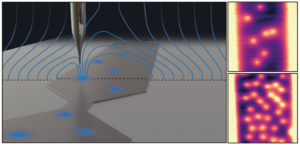2019 News
December 2019
Artificial Spin Ice Paper Published
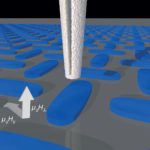 On Tuesday the 10th, the journal ACS Nano published our paper entitled, Stray-Field Imaging of a Chiral Artificial Spin Ice during Magnetization Reversal, as a “Just Accepted Manuscript”. The manuscript describes our use of a scanning nanometer-scale superconducting quantum interference device (SQUID) to image the magnetic stray field distribution of an artificial spin ice system exhibiting structural chirality as a function of applied magnetic fields at 4.2 K. The images reveal that the magnetostatic interaction gives rise to a measurable bending of the magnetization at the edges of the nanomagnets. Micromagnetic simulations predict that, owing to the structural chirality of the system, this edge bending is asymmetric in the presence of an external field and gives rise to a preferred direction for the reversal of the magnetization, an effect not captured by models assuming a uniform magnetization. Our technique thus provides a promising new means for understanding the collective response of artificial spin ices and their interactions.
On Tuesday the 10th, the journal ACS Nano published our paper entitled, Stray-Field Imaging of a Chiral Artificial Spin Ice during Magnetization Reversal, as a “Just Accepted Manuscript”. The manuscript describes our use of a scanning nanometer-scale superconducting quantum interference device (SQUID) to image the magnetic stray field distribution of an artificial spin ice system exhibiting structural chirality as a function of applied magnetic fields at 4.2 K. The images reveal that the magnetostatic interaction gives rise to a measurable bending of the magnetization at the edges of the nanomagnets. Micromagnetic simulations predict that, owing to the structural chirality of the system, this edge bending is asymmetric in the presence of an external field and gives rise to a preferred direction for the reversal of the magnetization, an effect not captured by models assuming a uniform magnetization. Our technique thus provides a promising new means for understanding the collective response of artificial spin ices and their interactions.
Post-doc Dr. Marcus Wyss led and carried out the experiments in our lab with help from Dr. Denis Vasyukov, Lorenzo Ceccarelli, and Giulio Romagnoli. Dr. Sebastian Gliga, the corresponding author, and his collaborators fabricated the artificial spin ice and carried out the simulations.
November 2023
SPIN Site Visit
On the 16th and 17th, the large collaborative project NCCR SPIN on “Spin qubits in Si” lead by members of our Department hosted a site visit. As part of the collaboration, members of the group attended talks and presented posters including Ph.D. students Liza Žaper, Andriani Vervelaki, Aurèle Kamber, and Luca Forrer. Prof. Poggio gave a summary talk.
Raffi Budakian Visits
On the 6th and 7th, Prof. Raffi Budakian of the University of Waterloo, Canada visited our group here at the Department of Physics. Raffi gave a talk on the afternoon of the 6th at our department’s Quantum & Nano Seminar entitled, “Novel Approaches in NanoMRI for Probing Atomic-Scale Material Structure”.
October 2019
Prof. Manuel Vázquez Visits
On Monday the 21st, Prof. Manuel Vázquez from the Instituto de Ciencia de Materiales, CSIC, in Madrid was invited by Prof. Poggio to give the Nano and Quantum Seminar here in the department. His talk was entitled, “Modulated cylindrical nanowires: from synthesis to domain structure and magnetization reversal”. Prof. Vázquez, who is an expert in magnetic nanowires, visited our group on Monday and Tuesday to discuss potential collaborations.
Marcus Wyss Speaks in Tübingen
On Friday the 11th, Dr. Marcus Wyss gave the Institutsseminar at the Center for Quantum Science in the Physics Department of the University of Tübingen. His talk was entitled, “Nanoscale Imaging of magnetic structures”. Prof. Poggio and Dr. Boris Groß joined Marcus for the visit and the two spent Thurday and Friday discussing collaborative projects with their host, Prof. Dieter Kölle and his group members.
Group Bike Tour
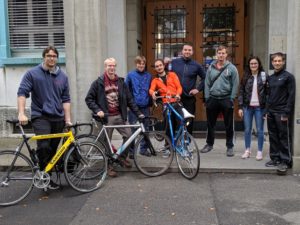 On Sunday the 6th, group members went on a bike tour from the department to Rötteln Castle, just outside Basel in Lörrach, Germany. Although a persistent rain deterred us from making it up to the castle, the weather and two flat tires couldn’t stop us from enjoying some roadside whiskey and a hearty lunch at the Brauhaus Lasser. Thanks to Giulio Romagnoli for organizing. Pictures are here.
On Sunday the 6th, group members went on a bike tour from the department to Rötteln Castle, just outside Basel in Lörrach, Germany. Although a persistent rain deterred us from making it up to the castle, the weather and two flat tires couldn’t stop us from enjoying some roadside whiskey and a hearty lunch at the Brauhaus Lasser. Thanks to Giulio Romagnoli for organizing. Pictures are here.
Masters Student Joins Group
Arsalan Saeedi joined our group as a Masters student in early October. Arsalan received his Bachelor of Science in Physics from the University of Basel in 2017. He is joining our lab to do his Masters project on integrating a nanomechanical oscillator into a high-finesse optical cavity.
September 2019
Introduction to Nanomechanics Starts
On Wednesday the 18th, the Master-level lecture “Introduction to Nanomechanics” started. The lecture will take place every Wednesday from 10:00 to 12:00 in 1.22 until the 18th of December. The course (not surprisingly) focuses on the mechanics of very small objects. In particular, we will discuss the regime of nanometer-scale objects where classical theory begins to break down and quantum mechanical behavior emerges. In order to do so, we will touch on continuum mechanics, statistical mechanics, opto-mechanics, and quantum mechanics. After covering the fundamentals of the field, we will study its most important results up to and including contemporary work. We will discuss efforts to bring nanomechanical resonators into the quantum mechanical regime. We will also emphasize the most practical and successful applications of these devices, i.e. as sensors of force, mass, and displacement.
Masters Student Joins Group
Lukas Schneider joined our group as a Masters student in mid-September. Lukas received his Bachelor of Science in Nanoscience from the University of Basel in 2018. He carried out one of his two short Masters projects in our lab on magnetic nanowire (NW) sensors. He will continue work in this direction during his full Masters project, working on NW as scanning probe sensors.
Paper on Imaging Superconducting Vortices Published
On Thursday the 5th, Physical Review B, published our article entitled, Imaging pinning and expulsion of individual superconducting vortices in amorphous MoSi thin films. The manuscript reports the first images of individual superconducting vortices in thin films used in the production of sensitive photon detectors. Superconducting vortices are tiny whirl-like configurations of supercurrent, which flow around a non-superconducting core and allow a quantum of magnetic flux to penetrate a superconductor. Newly developed superconducting nanowire single photon detectors (SNSPDs) are fast, efficient, and extremely sensitive, making them attractive for many cutting-edge applications. How exactly they work, however, remains poorly understood. Recently, evidence has emerged that superconducting vortices are crucial both in the mechanism used for the detection of photons and in the generation of dark counts. For this reason, we used an ultra-sensitive nanometer-scale superconducting quantum interference device (SQUID) fabricated on the end of a sharp scanning probe – a so-called SQUID-on-tip – to investigate vortices in MoSi, one of the materials used in SNSPDs. The tiny scanning probe made images showing where the vortices appear, how they move, and how they get trapped – or ‘pinned’ – on defects in the material. The work suggests that control of the density and strength of these pinning sites is important for the optimization of SNSPD devices based on amorphous thin films. Given that vortex motion contributes to loss in many superconducting circuits – including those used as qubits in quantum computers – such experiments may prove useful on a variety of other superconducting circuits.
Ph.D. student Lorenzo Ceccarelli carried out the experiments, analyzed the data, and led the work. Early contributions were made by former post-doc Dr. Denis Vasyukov. Post-docs Dr. Marcus Wyss, Dr. Nicola Rossi, and Ph.D student Giulio Romagnoli made various contributions to the experiments with Nicola also contributing to the figures for the manscript. Post-doc Dr. Lucas Moser of the Meyer group carried out X-ray photoelectron spectroscopy of the MoSi samples.
New Department Chair
Effective on the 1st, Prof. Poggio took over from Prof. Dominik Zumbühl as the new Chair of the Department of Physics.
August 2019
Zardo/Poggio Workshop
On Friday the 30th, we organized a day-long workshop with our colleagues in the Zardo Group here in Basel. The workshop focused on “Thermal Microscopy”, but also gave everyone involved an overview of the research project being carried out in the two groups. Our group contributed with informal talks by Ph.D. students Hinrich Mattiat, Thibaud Ruelle, Giulio Romagnoli, and Prof. Poggio. With this first meeting, we hope to encourage joint projects and collaborations in the future. In between talks, we enjoyed a joint lunch at Taverne Johann, across the street from the department.
Boris and Simon in Uppsala
From the 26th to the 30th, research scientist Dr. Boris Groß and Ph.D. student Simon Philipp attended the Joint European Magnetic Symposia (JEMS) in Uppsala, Sweden. This meeting is the most important and comprehensive conference on magnetism in Europe. On Thursday the 29th, Simon gave a talk entitled, “Dynamic cantilever magnetometry of individual maghemite mesocrystals”.
 Machine shop / Poggio Lab BBQ
Machine shop / Poggio Lab BBQ
On Friday the 23rd, we enjoyed our annual summer barbeque on the roof of the department with our colleagues from the Machine Shop. Thanks to all the friends and colleagues who came, especially the alumni. Some pictures are here. See you next year!
July 2019
Lorenzo at Coma-ruga
From the 1st to the 5th, Ph.D. student Lorenzo Ceccarelli attended the 15th International Workshop on Magnetism & Superconductivity at the Nanoscale (Coma-ruga 2019) in Coma-ruga, Spain. This annual event includes discussion and presentations in all areas of nanomagnetic and superconducting research, including spintronics, novel magnetic and superconducting phases, and low-dimensional systems. Lorenzo gave a talk about his most recent work on the evening of the 1st entitled, “Imaging superconducting vortex dynamics in amorphous MoSi thin films”.
Nicola Rossi Graduates
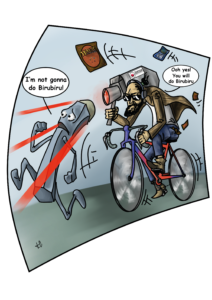 On the 1st, Ph.D. student Nicola Rossi defended his thesis, entitled “Force sensing with nanowires”, earning his doctorate in Physics summa cum laude. The exam was chaired by Prof. Ernst Meyer with Prof. Poggio and Prof. Adrian Bachtold (ICFO, Barcelona) making up the committee. Nicola started as a Ph.D. student in June 2014 with the support of our ERC Starting Grant on using nanowires (NWs) as sensitive scanning probes. Nicola was the first to demonstrate a new type of atomic force microscope (AFM) using NWs as sensitive transducers. Unlike standard AFM, the NW-based technique enables measurements of both the size and direction of forces. He later showed that magnet-tipped NWs can be used for imaging extremely weak magnetic field patterns on the nanometer-scale, as required for mapping mesoscopic transport and spin textures or in nanometer-scale magnetic resonance. Fortunately for us, Nicola will stay at least until the end of the year to finish some ongoing scientific projects here in the lab. Congratulations to Dr. Rossi!
On the 1st, Ph.D. student Nicola Rossi defended his thesis, entitled “Force sensing with nanowires”, earning his doctorate in Physics summa cum laude. The exam was chaired by Prof. Ernst Meyer with Prof. Poggio and Prof. Adrian Bachtold (ICFO, Barcelona) making up the committee. Nicola started as a Ph.D. student in June 2014 with the support of our ERC Starting Grant on using nanowires (NWs) as sensitive scanning probes. Nicola was the first to demonstrate a new type of atomic force microscope (AFM) using NWs as sensitive transducers. Unlike standard AFM, the NW-based technique enables measurements of both the size and direction of forces. He later showed that magnet-tipped NWs can be used for imaging extremely weak magnetic field patterns on the nanometer-scale, as required for mapping mesoscopic transport and spin textures or in nanometer-scale magnetic resonance. Fortunately for us, Nicola will stay at least until the end of the year to finish some ongoing scientific projects here in the lab. Congratulations to Dr. Rossi!
New Post-doc Starts
On the 1st, Dr. Estefani Marchiori started work in the group as post-doctoral researcher. Estefani earned her Ph.D. in Physics in the spring of 2019 from the University of Bath. There she worked with Prof. Simon Bending, studying the interplay between ferromagnetism and superconductivity at the nanometer-scale through measurements of transport, magnetization, and by scanning Hall microscopy. The aim was to understand and control odd frequency spin-triplet superconducting correlations (long range proximity effects) in hybrid structures. Welcome Estefani!
June 2019
Annual Birsköpfli BBQ
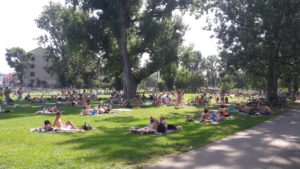 On the 30th, group members, alumni and alumnae, and friends met up for for the 3rd year at the Birsköpfli park along the Rhine river for a barbecue, drinks, games, and cooling off in the river. Thanks to all for a good time! Pictures and movies are here.
On the 30th, group members, alumni and alumnae, and friends met up for for the 3rd year at the Birsköpfli park along the Rhine river for a barbecue, drinks, games, and cooling off in the river. Thanks to all for a good time! Pictures and movies are here.
Floris in Firenze
From the 4th to the 5th, Dr. Floris Braakman attended a mid-term meeting of the Quantera project “QuaSeRT” in Firenze, Italy. The meeting was held at the last home of Galileo Galilei, Villa “Il Gioiello”. As a researcher outside the QuSeRT collaboration, Floris gave a talk on the 5th describing our recent work in nanowire sensing and optomechanics.
May 2019
Sola Basel
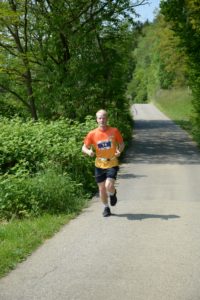 On the 25th, Ph.D. students Hinrich Mattiat and Giulio Romagnoli and Prof. Poggio took part in the 2nd annual Sola Basel running relay along with members of the Zardo Group and friends. The 10-person teamed ended up in 29th place with help from Giulio, Hinrich, and Martino placing 10th, 14th, and 17th in their respective legs.
On the 25th, Ph.D. students Hinrich Mattiat and Giulio Romagnoli and Prof. Poggio took part in the 2nd annual Sola Basel running relay along with members of the Zardo Group and friends. The 10-person teamed ended up in 29th place with help from Giulio, Hinrich, and Martino placing 10th, 14th, and 17th in their respective legs.
Paper Published in Applied Optics
 On the 6th, Applied Optics published our manuscript entitled, Optimized single-shot laser ablation of concave mirror templates on optical fibers. The manuscript describes a process for realizing mirror templates on the tips of optical fibers by single-shot CO2 laser ablation. It also presents a systematic study of the influence of the pulse power, pulse duration, and laser spot size on their geometry. The investigation provides new insights into CO2 laser ablation of optical fibers and should help improve current models. Notably, the study finds that the radius of curvature, depth, and diameter of the templates exhibit extrema as a function of the power and duration of the ablation pulse, and shows that compound convex–concave shapes can be obtained. In the paper, we also identify regimes of ablation parameters that lead to mirror templates with favorable geometries for use in cavity quantum electrodynamics and optomechanics.
On the 6th, Applied Optics published our manuscript entitled, Optimized single-shot laser ablation of concave mirror templates on optical fibers. The manuscript describes a process for realizing mirror templates on the tips of optical fibers by single-shot CO2 laser ablation. It also presents a systematic study of the influence of the pulse power, pulse duration, and laser spot size on their geometry. The investigation provides new insights into CO2 laser ablation of optical fibers and should help improve current models. Notably, the study finds that the radius of curvature, depth, and diameter of the templates exhibit extrema as a function of the power and duration of the ablation pulse, and shows that compound convex–concave shapes can be obtained. In the paper, we also identify regimes of ablation parameters that lead to mirror templates with favorable geometries for use in cavity quantum electrodynamics and optomechanics.
Ph.D. student Thibaud Ruelle was the driving force behind this work, carrying out the experiments and modelling the results. Dr. Floris Braakman led and supervised the work as part of his 2015 Ambizione grant from the Swiss National Science Foundation.
April 2019
Basel-Zürich 3-1
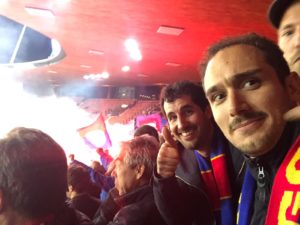 On the 25th, post-doc Dr. Marcus Wyss and Ph.D. student Giulio Romagnoli traveled to the Letzigrund stadium to represent the group in support of the local football club at the semi-final of the 2019 Swiss Cup. They enjoyed watching FC Basel thrash a team from a neighboring city in a 3-1 victory worth a spot in the Swiss Cup final. A good time was had both at the match and on the ride to and from the game on a ‘special’ train for FC Basel fans.
On the 25th, post-doc Dr. Marcus Wyss and Ph.D. student Giulio Romagnoli traveled to the Letzigrund stadium to represent the group in support of the local football club at the semi-final of the 2019 Swiss Cup. They enjoyed watching FC Basel thrash a team from a neighboring city in a 3-1 victory worth a spot in the Swiss Cup final. A good time was had both at the match and on the ride to and from the game on a ‘special’ train for FC Basel fans.
Zurich Instruments User Meeting
On the 25th and 26th, Ph.D students Thibaud Ruelle, Hinrich Mattiat, Simon Philipp, and Nicola Rossi; post-doc Dr. Boris Groß; and Prof. Poggio attended the 3rd Zurich Instruments User Meeting on SPM & Magnetism held at ETH Zürich. The meeting was hosted by Prof. Christian Degen and included talks, practical tutorials, and tours of labs and of Zurich Instruments headquarters. Prof. Poggio gave a talk on the morning of the 25th entitled, “New scanning probes for nanomagnetic imaging”.
Review on Nanowire Force Sensing Published
On the 16th, Nanotechnology published a topical review written by Dr. Floris Braakman and Prof. Poggio entitled, Force sensing with nanowire cantilevers. The paper discusses the motivation behind using nanowires as force transducers, explain the methods of force sensing with nanowire cantilevers, and gives an overview of the experimental progress so far and future prospects of the field.
Prof. Poggio at DPG Spring Meeting
 On the 2nd, Prof. Poggio gave an invited talk at the annual Spring Meeting of the Deutsche Physikalische Gessellschaft (DPG) in Regensburg, Germany. On the invitation of session organizer, Dr. Denys Makarov, Prof. Poggio gave a talk entitled, “Magnetization configurations and reversal of individual ferromagnetic nanotubes“. This talk was part of a special symposium on “Geometry, Topology, and Condensed Matter“.
On the 2nd, Prof. Poggio gave an invited talk at the annual Spring Meeting of the Deutsche Physikalische Gessellschaft (DPG) in Regensburg, Germany. On the invitation of session organizer, Dr. Denys Makarov, Prof. Poggio gave a talk entitled, “Magnetization configurations and reversal of individual ferromagnetic nanotubes“. This talk was part of a special symposium on “Geometry, Topology, and Condensed Matter“.
Seminar at Walter Schottky Institute
On the 1st, Prof. Poggio visited Prof. Gregor Kolbmueller and Prof. Jonathan Finley at the Walter Schottky Institute (WSI) of the Technical Univeristy of Munich (TUM). He discussed an ongoing collaboration and visited research groups at TUM. In the afternoon, he gave a ‘Schottky Seminar’ entitled, “New scanning probes for nanomagnetic imaging“.
March 2019
Group at APS March Meeting
From the 4th to the 8th, members of the group attended the annual APS March Meeting, which was held in Boston this year. Ph.D. students Hinrich Mattiat, Nicola Rossi, and Lorenzo Ceccarelli; post-docs Dr. Floris Braakman and Dr. Marcus Wyss; and Prof. Poggio made the trip to attend the 11,000-person conference. Hinrich gave a talk entitled, “FEBID-grown iron and cobalt nanowires as magnetic force sensors“; Nicola a talk entitled, “Magnetic force sensing using a self-assembled GaAs nanowire with a MnAs tip“; Lorenzo a talk entitled, “Imaging individual superconducting vortices in amorphous Mo0.8Si0.2 by scanning SQUID-on-tip“; Marcus a talk entitled, “Imaging the stray field of chiral artificial spin ice with scanning nanoSQUID-on-tip“; and Floris a talk and a poster entitled, “Optimized single-shot laser ablation of concave mirror templates on optical fibers” and “Hole spins in Ge/Si nanowires“, respectively.
February 2019
Physics II for Physicists Starts
On Thursday the 21st, the lecture “Introduction to Physics II for Physicists: Electrodynamics and Optics” began and will run until Friday, May 24th. The exam is scheduled for June 20st, 2019, 10:00 – 13:00. The lecture covers the basics of electrostatics, magnetostatics, electrodynamics, and optics. Prof. Philipp Treutlein and Prof. Poggio are sharing lecturing responsibilities.
Group Members at Arosa Meeting or Lorenzo Speaks and Thibaud Knows He’s #1
From the 4th to the 8th, members of the group attended the 8th NCCR Winter School and 9th NCCR QSIT General Meeting in Arosa, Switzerland. Ph.D. student Hinrich Mattiat attended both the school and the meeting, while Ph.D. students Lorenzo Ceccarelli, Giulio Romagnoli, Thibaud Ruelle, post-doc Boris Groß, and Prof. Poggio attended the meeting. Hinrich and Thibaud presented posters on their work and Lorenzo gave a talk on the 8th entitled, “Imaging individual superconducting vortices in amorphous Mo Si by scanning SQUID-on-tip”. On the afternoon of the 7th, Thibaud — after predicting victory — crushed the competition and won the annual QSIT ski race, becoming the first group member to do so. Congratulations! Also, a special thanks to Ilona Blatter for her long and crucial service to QSIT and to Klara Berg for organizing and excellent meeting.
January 2019
Floris at Nano in the Snow
From the 23rd to the 25th, post-doc Dr. Floris Braakman attended the annual “Nanoscience in the Snow” Workshop organized by the Swiss Nanoscience Institute and held this year at the Hotel Crystal Braunwald. Floris gave a talk in the morning of Thursday the 24th.
Nanowire MFM Paper Published
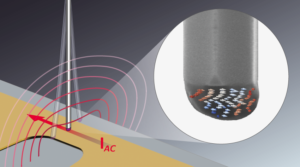 On the 2nd, our manuscript entitled, Magnetic force sensing using a self-assembled nanowire, was published by Nano Letters. In the study, we present a scanning magnetic force sensor based on an individual magnet-tipped GaAs nanowire (NW) grown by molecular beam epitaxy. Its magnetic tip consists of a final segment of single-crystal MnAs formed by sequential crystallization of the liquid Ga catalyst droplet. We characterize the mechanical and magnetic properties of such NWs by measuring their flexural mechanical response in an applied magnetic field. Comparison with numerical simulations allows the identification of their equilibrium magnetization configurations, which in some cases include magnetic vortices. To determine a NW’s performance as a magnetic scanning probe, we measure its response to the field profile of a lithographically patterned current-carrying wire. The NWs’ tiny tips and their high force sensitivity make them promising for imaging weak magnetic field patterns on the nanometer-scale, as required for mapping mesoscopic transport and spin textures or in nanometer-scale magnetic resonance.
On the 2nd, our manuscript entitled, Magnetic force sensing using a self-assembled nanowire, was published by Nano Letters. In the study, we present a scanning magnetic force sensor based on an individual magnet-tipped GaAs nanowire (NW) grown by molecular beam epitaxy. Its magnetic tip consists of a final segment of single-crystal MnAs formed by sequential crystallization of the liquid Ga catalyst droplet. We characterize the mechanical and magnetic properties of such NWs by measuring their flexural mechanical response in an applied magnetic field. Comparison with numerical simulations allows the identification of their equilibrium magnetization configurations, which in some cases include magnetic vortices. To determine a NW’s performance as a magnetic scanning probe, we measure its response to the field profile of a lithographically patterned current-carrying wire. The NWs’ tiny tips and their high force sensitivity make them promising for imaging weak magnetic field patterns on the nanometer-scale, as required for mapping mesoscopic transport and spin textures or in nanometer-scale magnetic resonance.
Ph.D. student Nicola Rossi led the research and carried out the experiments. Dr. Boris Groß developed and ran the micromagnetic simulations. Ph.D. student Florian Dirnberger and Prof. Dominique Bougeard from the Universität Regensburg grew the magnet-tipped NWs used in the experiments.

